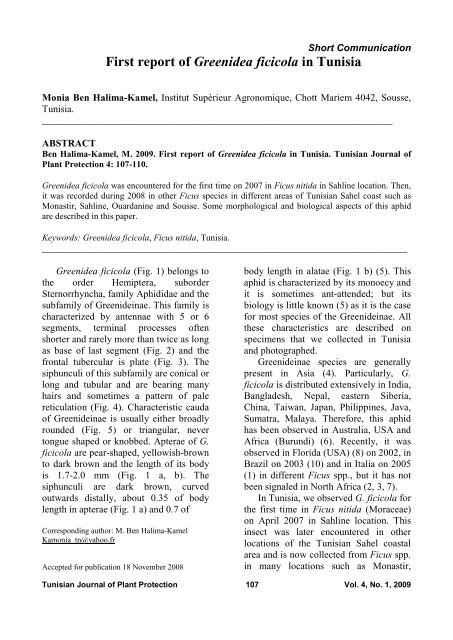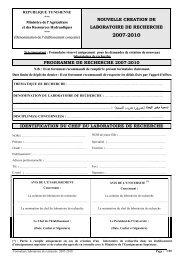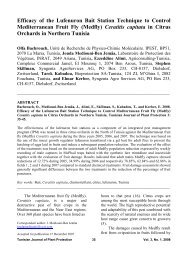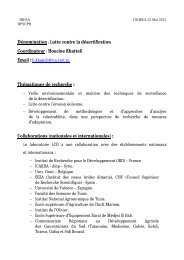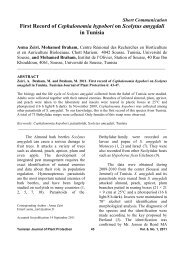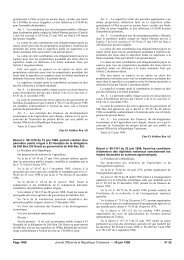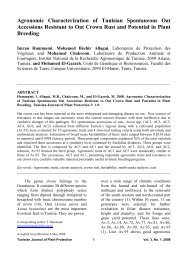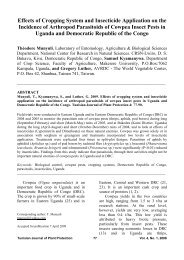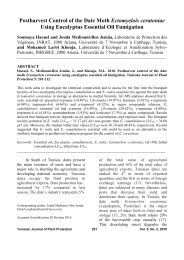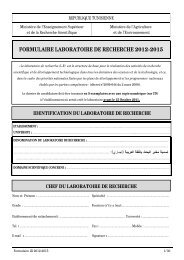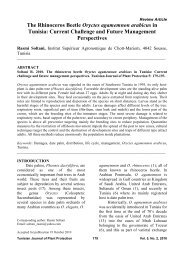107. First report of Greenidea ficicola in Tunisia. M. Ben ... - Iresa
107. First report of Greenidea ficicola in Tunisia. M. Ben ... - Iresa
107. First report of Greenidea ficicola in Tunisia. M. Ben ... - Iresa
You also want an ePaper? Increase the reach of your titles
YUMPU automatically turns print PDFs into web optimized ePapers that Google loves.
Short Communication<strong>First</strong> <strong>report</strong> <strong>of</strong> <strong>Greenidea</strong> <strong>ficicola</strong> <strong>in</strong> <strong>Tunisia</strong>Monia <strong>Ben</strong> Halima-Kamel, Institut Supérieur Agronomique, Chott Mariem 4042, Sousse,<strong>Tunisia</strong>._______________________________________________________________________ABSTRACT<strong>Ben</strong> Halima-Kamel, M. 2009. <strong>First</strong> <strong>report</strong> <strong>of</strong> <strong>Greenidea</strong> <strong>ficicola</strong> <strong>in</strong> <strong>Tunisia</strong>. <strong>Tunisia</strong>n Journal <strong>of</strong>Plant Protection 4: 107-110.<strong>Greenidea</strong> <strong>ficicola</strong> was encountered for the first time on 2007 <strong>in</strong> Ficus nitida <strong>in</strong> Sahl<strong>in</strong>e location. Then,it was recorded dur<strong>in</strong>g 2008 <strong>in</strong> other Ficus species <strong>in</strong> different areas <strong>of</strong> <strong>Tunisia</strong>n Sahel coast such asMonastir, Sahl<strong>in</strong>e, Ouardan<strong>in</strong>e and Sousse. Some morphological and biological aspects <strong>of</strong> this aphidare described <strong>in</strong> this paper.Keywords: <strong>Greenidea</strong> <strong>ficicola</strong>, Ficus nitida, <strong>Tunisia</strong>.__________________________________________________________________________<strong>Greenidea</strong> <strong>ficicola</strong> (Fig. 1) belongs tothe order Hemiptera, suborderSternorrhyncha, family Aphididae and thesubfamily <strong>of</strong> Greenide<strong>in</strong>ae. This family ischaracterized by antennae with 5 or 6segments, term<strong>in</strong>al processes <strong>of</strong>tenshorter and rarely more than twice as longas base <strong>of</strong> last segment (Fig. 2) and thefrontal tubercular is plate (Fig. 3). Thesiphunculi <strong>of</strong> this subfamily are conical orlong and tubular and are bear<strong>in</strong>g manyhairs and sometimes a pattern <strong>of</strong> palereticulation (Fig. 4). Characteristic cauda<strong>of</strong> Greenide<strong>in</strong>ae is usually either broadlyrounded (Fig. 5) or triangular, nevertongue shaped or knobbed. Apterae <strong>of</strong> G.<strong>ficicola</strong> are pear-shaped, yellowish-brownto dark brown and the length <strong>of</strong> its bodyis 1.7-2.0 mm (Fig. 1 a, b). Thesiphunculi are dark brown, curvedoutwards distally, about 0.35 <strong>of</strong> bodylength <strong>in</strong> apterae (Fig. 1 a) and 0.7 <strong>of</strong>Correspond<strong>in</strong>g author: M. <strong>Ben</strong> Halima-KamelKamonia_tn@yahoo.frAccepted for publication 18 November 2008body length <strong>in</strong> alatae (Fig. 1 b) (5). Thisaphid is characterized by its monoecy andit is sometimes ant-attended; but itsbiology is little known (5) as it is the casefor most species <strong>of</strong> the Greenide<strong>in</strong>ae. Allthese characteristics are described onspecimens that we collected <strong>in</strong> <strong>Tunisia</strong>and photographed.Greenide<strong>in</strong>ae species are generallypresent <strong>in</strong> Asia (4). Particularly, G.<strong>ficicola</strong> is distributed extensively <strong>in</strong> India,Bangladesh, Nepal, eastern Siberia,Ch<strong>in</strong>a, Taiwan, Japan, Philipp<strong>in</strong>es, Java,Sumatra, Malaya. Therefore, this aphidhas been observed <strong>in</strong> Australia, USA andAfrica (Burundi) (6). Recently, it wasobserved <strong>in</strong> Florida (USA) (8) on 2002, <strong>in</strong>Brazil on 2003 (10) and <strong>in</strong> Italia on 2005(1) <strong>in</strong> different Ficus spp., but it has notbeen signaled <strong>in</strong> North Africa (2, 3, 7).In <strong>Tunisia</strong>, we observed G. <strong>ficicola</strong> forthe first time <strong>in</strong> Ficus nitida (Moraceae)on April 2007 <strong>in</strong> Sahl<strong>in</strong>e location. This<strong>in</strong>sect was later encountered <strong>in</strong> otherlocations <strong>of</strong> the <strong>Tunisia</strong>n Sahel coastalarea and is now collected from Ficus spp.<strong>in</strong> many locations such as Monastir,<strong>Tunisia</strong>n Journal <strong>of</strong> Plant Protection 107 Vol. 4, No. 1, 2009
Sahl<strong>in</strong>e, Ouardan<strong>in</strong>e and Sousse on 2008.Therefore, these observations show anextension <strong>of</strong> the distribution range <strong>of</strong> G.<strong>ficicola</strong> <strong>in</strong> <strong>Tunisia</strong> giv<strong>in</strong>g anotherexample <strong>of</strong> biological <strong>in</strong>vasion by anaphid <strong>in</strong> <strong>Tunisia</strong>, similar to the earlier<strong>in</strong>vasion with Pterochlorides persicaealso from Asia (11). G. <strong>ficicola</strong> livesma<strong>in</strong>ly at the lower side <strong>of</strong> young leavesand on shoots <strong>of</strong> Ficus spp., but there areIndian records <strong>in</strong> other hosts. In this case,it was <strong>in</strong>dicated (5) that this aphid can bemet on dicotyledonous trees and shrubsand lives ma<strong>in</strong>ly <strong>in</strong> shoots and youngfoliage <strong>of</strong> trees, particularly Fagaceae, butalso Moraceae, Betulaceae, Juglandaceaeand less commonly on members <strong>of</strong>evolutionary more recent families such asMyrtaceae, Rosaceae and Rubiaceae (9).The presence <strong>of</strong> this pest causes enrolledleaves and recovered leaves and fruitswith honeydew on F. nitida. Thesedamages <strong>in</strong>duced weaken<strong>in</strong>g <strong>of</strong> treesconsidered among the most widespread <strong>in</strong>the urban zones and further studies aboutG. <strong>ficicola</strong> as a possible pest on figorchards <strong>in</strong> <strong>Tunisia</strong> are recommended.Two factors may expla<strong>in</strong> theoccurrence <strong>of</strong> G. <strong>ficicola</strong> <strong>in</strong> <strong>Tunisia</strong>.<strong>First</strong>ly, exotic and native Ficus speciesare widely planted as ornamental trees <strong>in</strong>parks or streets and this <strong>of</strong>fers many hostplants to this aphid. Trades with Asiancountries have <strong>in</strong>creased <strong>in</strong> the past twodecades <strong>in</strong>creas<strong>in</strong>g the probability <strong>of</strong>transport<strong>in</strong>g accidentally this aphid <strong>in</strong> oron goods from this region <strong>of</strong> the world.Fig. 1. General appearance <strong>of</strong> G. <strong>ficicola</strong> (A: Apterae, B: Alatae, C: Larva).Fig. 2. Antennae <strong>of</strong> G. <strong>ficicola</strong> (I, II, III, V, V, VI, and VII: articles).<strong>Tunisia</strong>n Journal <strong>of</strong> Plant Protection 108 Vol. 4, No. 1, 2009
Fig. 3. Frontal tubercular <strong>of</strong> G. Ficicola.Fig. 4: Siphunculi <strong>of</strong> G. <strong>ficicola</strong>.Fig. 5: Cauda <strong>of</strong> G. <strong>ficicola</strong>.ACKNOWLEDGEMENTThe author is grateful to Dr. Faouzi Haoula for plant determ<strong>in</strong>ation.__________________________________________________________________________RESUME<strong>Ben</strong> Halima-Kamel M. 2009. Première observation de <strong>Greenidea</strong> <strong>ficicola</strong> en Tunisie. <strong>Tunisia</strong>nJournal <strong>of</strong> Plant Protection 4: 107-110.<strong>Greenidea</strong> <strong>ficicola</strong> a été rencontré pour la première fois sur Ficus nitida en 2007 à la localité deSahl<strong>in</strong>e. Ensuite, il a été observé durant 2008 sur d’autres espèces de Ficus dans différentes régionscôtières du Sahel tunisien telles que Monastir, Sahl<strong>in</strong>e, Ourdan<strong>in</strong>e et Sousse. Quelques aspectsmorphologiques et biologiques de ce puceron sont décrits dans le texte.Mots clés : <strong>Greenidea</strong> <strong>ficicola</strong>, Ficus nitida, Tunisie.______________________________________________________________________________<strong>Tunisia</strong>n Journal <strong>of</strong> Plant Protection 109 Vol. 4, No. 1, 2009
___________________________________________________________________________Ficus.2009<strong>Tunisia</strong>n Journal <strong>of</strong> Plant Protection 4: 107-110ملخصمنية آامل بن حليمة.بتونس.أول تقرير حول وجود حشرة المن <strong>Greenidea</strong> <strong>ficicola</strong>على التين التصفيفىnitidaفيسنة على نباتتم العثور لأول مرة على حشرة المنمنطقة الساحلين. ثم تم تسجيله أثناء على أنواع أخرى من التين في مناطق مختلفة من الساحل التونسي على غرارالمنستير والساحلين والوردانين وسوسة. ويوجد في النص وصف لبعض الخصائص المورفولوجية والبيولوجية لهذاالحشرة.2007 التين التصفيفي . Ficus nitida<strong>Greenidea</strong> <strong>ficicola</strong>2008،Ficus nitida،<strong>Greenidea</strong> <strong>ficicola</strong> :___________________________________________________________________________آلمات مفتاحيةالمنالتين التصفيفيتونسLITERATURE CITED1. Barbagallo, S., Bella, S., and Cocuiza, G. 2005.R<strong>in</strong>venimento dell'afide orientale <strong>Greenidea</strong><strong>ficicola</strong> su Ficus ornamentali <strong>in</strong> Italiameridionale. Informatore fitopatologico 2: 25-29.2. <strong>Ben</strong> Halima-Kamel, M. and <strong>Ben</strong> Hamouda, M. H.1998. Contribution à l’étude de la bioécologiedes aphides d’une région côtière de la Tunisie.Med. Fac. Landbouww. Univ. Gent, 63: 365-378.3. <strong>Ben</strong> Halima-Kamel, M. & <strong>Ben</strong> Mabrouk, M.1998. Les pucerons d’une région côtière duSahel tunisien. Revue de Note faunique deGembloux 35: 49-64.4. Blackman, R.L. and Eastop, V.F. 1984. Aphidson the world's crops: An identification Guide.Jhon Wiley & Sons Limited. 2 nd edition. NewYork. 476 p.5. Blackman, R.L. and Eastop, V.F. 1994. Aphidson the world's trees: An identification and<strong>in</strong>formation Guide. Wall<strong>in</strong>gford, CAB, 986 p.6. Blackman, R.L. and Eastop, V.F. 2000. Aphidson the world's Herbacious plants and Shrubs:The Aphids. Second volume Jhon Wiley.Natural History Museum. New York. 1439 p.7. Boukris, S., Souissi, R., Turpeau, E., Rouze-Jouan, J., Mahamed, F., <strong>Ben</strong> Brahim, N., andHullé, M. 2007. Aphid (Hemiptera,Aphidoidea) diversity <strong>in</strong> <strong>Tunisia</strong> <strong>in</strong> relation toseed potato production. Ann. Soc. Entomol. Fr.43: 311-318.8. Halbert, S. E. 2004. The genus <strong>Greenidea</strong>(Rhynchota: Aphididae) <strong>in</strong> the United States.Florida Entomologist 87: 159-163.9. PaDIL. 2008. Pest and diseases image library.www.padil.gov.au/comparePestImages.aspx?pestIds.10. Sousa- Silva, C. R., Brombal, J. C., and Ilharco,F. A. 2005. <strong>Greenidea</strong> <strong>ficicola</strong> Takahashi(Hemiptera: Greenideidae), a new aphid <strong>in</strong>Brazil. Neotrop. Entomol. 34: 1023-1024.11. Trigui, A. & Cherif, R. 1987. Le puceron brun:Pterochlorides persicae (Cholodkovsky).Nouveau ravageur des arbres fruitiers enTunisie. Note de Recherche. Ann. INRATunisie 60: 12 p.----------------------------<strong>Tunisia</strong>n Journal <strong>of</strong> Plant Protection 110 Vol. 4, No. 1, 2009


